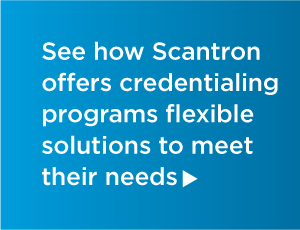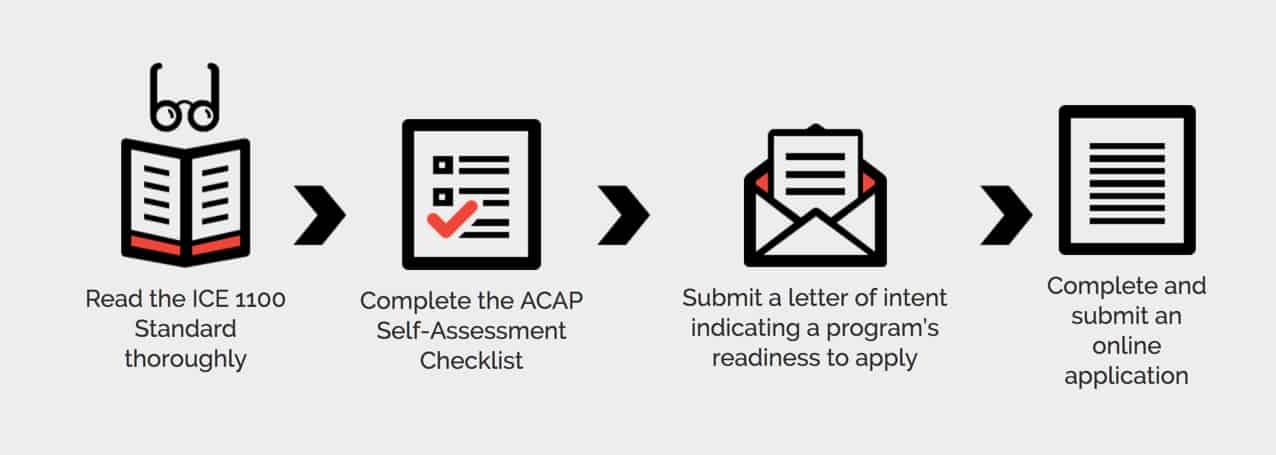This article was originally published in the Institute for Credentialing Excellence’s quarterly publication, ICE Digest, written by Sarah Carroll, PhD, Senior Psychometrician at Scantron .
 Accreditation is a process through which a credentialing program is evaluated against a set of defined standards and is awarded recognition if it complies with those standards. One reason why third-party accreditation is appealing to credentialing programs is that it can help them gain a competitive advantage over competing programs. Another reason is that third party accreditation provides some assurance to stakeholders that a credentialing program is adhering to industry best practice and meeting high standards for quality. The Institute for Credentialing Excellence (ICE) is a leading developer of standards for credentialing programs, as well as being a professional membership association that provides education, networking, and other resources for the credentialing industry. ICE currently offers accreditation to professional certification programs through the National Commission for Certifying Agencies (NCCA).
Accreditation is a process through which a credentialing program is evaluated against a set of defined standards and is awarded recognition if it complies with those standards. One reason why third-party accreditation is appealing to credentialing programs is that it can help them gain a competitive advantage over competing programs. Another reason is that third party accreditation provides some assurance to stakeholders that a credentialing program is adhering to industry best practice and meeting high standards for quality. The Institute for Credentialing Excellence (ICE) is a leading developer of standards for credentialing programs, as well as being a professional membership association that provides education, networking, and other resources for the credentialing industry. ICE currently offers accreditation to professional certification programs through the National Commission for Certifying Agencies (NCCA).
Most members of the credentialing community are familiar with the NCCA Standards for the Accreditation of Certification Programs and many readers of this article are probably aware that NCCA-accredited programs have demonstrated compliance to a rigorous set of standards that cover all aspects of a certification program, including governance, exam development, scoring and reporting of exam results, and recertification. What many members of the credentialing community do not realize is that there is another standard that provides guidance to organizations developing assessment-based certificate (ABC) programs. The ICE 1100 Standard for Assessment-Based Certificate Programs was published in 2009 and was the first American National Standard for ABC programs. A few years later, in 2012, ICE introduced the Assessment-Based Certificate Accreditation Program (ACAP), which accredits ABC programs based on the ICE 1100 Standard.
What Is an Assessment-Based Certificate Program?
An ABC program is a non-degree granting program that provides participants with training on a specific set of learning outcomes. After participants have completed the training course, they must demonstrate that they have accomplished these learning outcomes by passing an assessment that focuses specifically on the knowledge and skills covered in the course. Then, and only then, do they receive a certificate.

It is also important to note that an ABC program differs from a professional certification program in a few key ways. While an ABC program focuses on training and assessing mastery of a specific set of learning outcomes, a certification is much broader in focus and designed to assess competence or proficiency in an entire job role, profession or occupation. In addition, once an ABC program grants a certificate, these certificates do not expire and do not require ongoing education or training to maintain them as a general rule. However, exceptions may occur depending on the industry. Professional certifications, on the other hand, must be maintained on an ongoing basis through continuing education or other means of demonstrating continuing competence, and will expire if these requirements are not fulfilled. ICE has written a detailed white paper outlining the unique features of each type of program.

When Might an ABC Program Serve an Organization’s Needs Better than a Certification Program?
While certification programs are designed to assess knowledge or skills that have already been attained, certificate programs can help build capacity in an industry, emerging profession or specialty area. In addition, when there is an ongoing learning gap to fulfill a role or become workforce ready, an ABC program is better suited to address this gap. Finally, when highly specialized knowledge or skills are required for a particular job or role, a well-designed training program with learning outcomes that are aligned to the assessment can help confirm attainment of the requisite skills or competencies.
What Benefits Does ACAP Accreditation Offer to ABC Programs?
The number of organizations offering training courses and certificates seems to be increasing all the time. One indicator of a quality program is that it includes both a training component and an assessment of the learning outcomes (i.e., it is an ABC program). Even after narrowing it down to ABC programs, it can still be difficult to identify the highest quality programs. That’s where ACAP accreditation comes in. ACAP accreditation provides the public with assurance that an ABC program is adhering to industry best practices and running a high-quality program. It is a neutral, third-party validation that the ABC program complies with recognized national and international standards for the development, implementation and maintenance of training programs.
“ACAP accreditation provides the public with assurance that an ABC program is adhering to industry best practices and running a high-quality program.”
 What Is Covered by the ICE 1100 Standard?
What Is Covered by the ICE 1100 Standard?
ICE 1100 is a rigorous standard that covers the essential components of a high-quality ABC program, focusing on eight key sections:
- Program Scope
- Organizational Structure, Resources, and Responsibilities to Stakeholders
- Conduct and Oversight of Certificate Program Activities
- Management of Program Records, Documents and Materials
- Quality Assurance and Program Evaluation
- Development, Delivery and Maintenance of Education/Training
- Development, Conduct and Evaluation of Assessments
- Issuance and Use of Certificates
In each section, the Standard outlines several specific elements to which ABC programs must comply in order to be accredited. In some cases, the Standard is prescriptive and leaves little room for interpretation; in other cases, programs have a considerable amount of discretion when complying to the Standard and its essential elements.
The ACAC will make one of three decisions regarding an application:
- Begin the final validation and approval process, which may include an on-site audit.
- Defer the application until sufficient evidence or explanation of compliance to one or more standards can be provided.
- Deny the application based on significant non-conformity to the ICE 1100 Standard.
Does the Application Meet the ICE 1100 Standard?

What Are the Steps in the ACAP Accreditation Application Process?
The first step in the application process is to read the ICE 1100 Standard thoroughly with the goal of understanding the different sections and what kind of evidence is requested. In addition to the Standard itself, the ICE website has a number of related resources available, including guidance documents explaining different sections of the Standard in depth. Reading the Standard and all available support documents is an essential part of the application process.
The second step is to complete the ACAP Self-Assessment Checklist, which is located on the ICE website. The checklist is essentially an abbreviated version of the Standard, and its purpose is to help programs identify any potential deficiencies in their application, whether it is a lack of documentation or a change that needs to be made to the program. If there are any gaps in the application, it is critical that they are addressed prior to submitting it.
The third step is to submit a letter of intent indicating a program’s readiness to submit an application. The letter requires attestation that:
- the program has been administered successfully through one complete iteration;
- the submitter has read the ICE 1100 Standard and believes the program meets the criteria; and
- the submitter has completed the self-assessment checklist and believes that the program can furnish evidence that demonstrates compliance with the Standard.
The last step is to complete and submit an application online through a portal on the ICE website. The application provides guidance, templates and suggested documentation, and it should be used during the preparation process to improve the chances of successful application.

Tips for a Successful ACAP Application
All ACAP accreditation applications are reviewed by members of the Assessment-Based Certificate Accreditation Committee (ACAC), which includes administrative, instructional design and psychometric reviewers. Not surprisingly, the reason that the ACAC defers or denies applications is simply that the program has not provided sufficient evidence of compliance with the standards. There seems to be a common misconception that the expectations for quality of ABC programs are much lower than for that of certification programs and this is not necessarily the case. If an ABC program is considered high-stakes — that is, if passing the assessment is required for regulatory purposes or has important consequences for participants in the program, such as a promotion or a salary increase — the expectations for quality and rigor in the assessment will be akin to those of a certification program.
The best thing a program can do to increase its chances of being accredited is to ensure that it has a sufficient understanding of the types of evidence the ACAC is looking for. Reading the supporting documents that are available on the website, including the Instructional Design Guidance, Instructional Design Elements in ICE 1100, Guidelines for Meeting Assessment Requirements and using the sample ACAP templates provided on the ICE website will improve a program’s chances of submitting a complete application. If a program complies with most of the essential elements of the Standard but falls short in other areas, it may be worthwhile to consider retaining the services of a professional who can advise on compliance in those areas.
For most programs, becoming ACAP accredited will require a considerable amount of time and effort. However, expending this time and effort will result in a high-quality ABC program that will be recognized as such by members of the credentialing community and the public.
Further Resources
- Instructional Design Guidance
- Instructional Design Elements in ICE 1100
- Guidelines for Meeting Assessment Requirements
- Sample ACAP templates


Social
View our latest posts or connect with us below on Social Media.